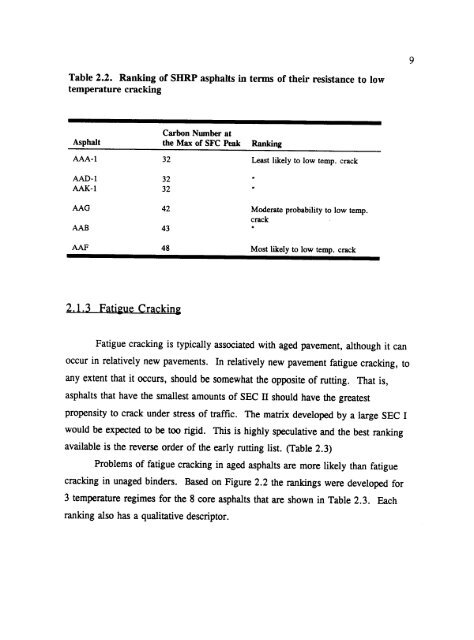Laboratory evaluation of aging for asphalt-aggregate mixtures
Laboratory evaluation of aging for asphalt-aggregate mixtures
Laboratory evaluation of aging for asphalt-aggregate mixtures
Create successful ePaper yourself
Turn your PDF publications into a flip-book with our unique Google optimized e-Paper software.
Table 2.2. Ranking <strong>of</strong> SHRP <strong>asphalt</strong>s in terms <strong>of</strong> their resistance to low<br />
temperature cracking<br />
Carbon Number at<br />
Asphalt the Max <strong>of</strong> SFC Peak Ranking<br />
AAA-1 32 Least likely to low temp. crack<br />
AAD-1 32 "<br />
AAK-1 32<br />
AAG 42 Moderate probability to low temp.<br />
crack<br />
AAB 43 "<br />
AAF 48 Most likely to low temp. crack<br />
2.1.3 Fatigue Cracking<br />
Fatigue cracking is typically associated with aged pavement, although it can<br />
occur in relatively new pavements. In relatively new pavement fatigue cracking, to<br />
any extent that it occurs, should be somewhat the opposite <strong>of</strong> rutting. That is,<br />
<strong>asphalt</strong>s that have the smallest amounts <strong>of</strong> SEC II should have the greatest<br />
propensity to crack under stress <strong>of</strong> traffic. The matrix developed by a large SEC I<br />
would be expected to be too rigid. This is highly speculative and the best ranking<br />
available is the reverse order <strong>of</strong> the early rutting list. (Table 2.3)<br />
Problems <strong>of</strong> fatigue cracking in aged <strong>asphalt</strong>s are more likely than fatigue<br />
cracking in unaged binders. Based on Figure 2.2 the rankings were developed <strong>for</strong><br />
3 temperature regimes <strong>for</strong> the 8 core <strong>asphalt</strong>s that are shown in Table 2.3. Each<br />
ranking also has a qualitative descriptor.<br />
9
















